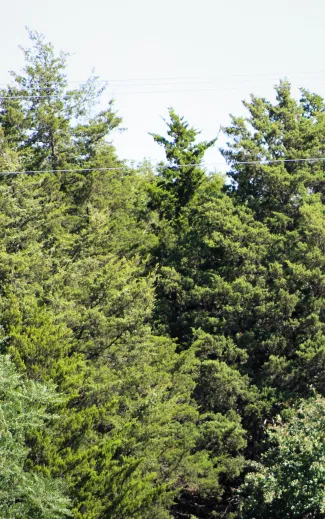Active Prescribed Burn List
No active burns currently on ODWC areas
Burning for Quail
Fire is one of the most important quail habitat management tools in our area. Burning performs several vital functions including removing accumulated litter, stimulating new growth, and controlling excessive woody invasion. Native rangelands that are burned periodically have a wider diversity of plants beneficial to quail than unburned prairies. Also, quail utilization on burned prairies will be greater than on unburned prairies for four reasons: 1) The litter has been removed from the ground level which aids in bird movement, 2) Burned units attract a greater density and diversity of insects which are critical to quail chicks, 3) Seed production is greater on burned prairies and 4) The ability of birds to feed on those seeds is improved.
Burn when there is a 5-15 mph wind, preferably in the stable atmosphere of one day after a storm front has moved through and when the humidity is above 40%. Remember that the wind tends to increase in speed throughout the day and generally decreases toward evening.
For best wildlife response burn in small units. On any area of 40-60 acres or larger burn only 1/3 of the unit annually. Use fire breaks that are maintained by disking or fall mowing. Burning only 1/3 of the unit annually allows a portion of the area to be in ideal nesting cover, a portion that is good nesting and fair brooding, and an area that regrows to ideal brooding sites.
If control of excessive woody plants is the objective of the burn then a "hot" fire is best. This is one which, after the backfires are secure, is set to travel with the wind and generate a lot of heat as it consumes the litter. "Cool" fires are most often used by wildlife managers. These are generally fires set to back into the wind or where the line of fire is parallel with the wind. Cool fires are easier to control and do a good job of leaving some woody cover intact. Cool late afternoon and nighttime burns are very good. The purpose is not generally to completely sweep the entire area black with fire but rather to enhance the "crazy quilt" pattern. Nighttime fires set when the wind is decreasing and humidity rising tend to go out in some spots and burn through the heavier cover creating a patchwork design.
If you would like to do a prescribed burn on your property there are several things you need to consider:
- Liability - you are responsible for your fire.
- Safety Considerations
- Notification Requirements
- Plan the Burn
- Control Lines
- Weather Considerations and
- Equipment/Crew Needs
The Oklahoma Department of Agriculture Forestry Service’s publication Notification Requirements and Considerations For Safe and Lawful Prescribed Burning in Oklahoma is available for you to download and print off. It will provide you with some basic guidelines so your burns will be safe and effective.
Controlling the Invasive Eastern Red Cedars
Oklahoma’s native forests, rangelands, pastures, and prairies are seriously threatened by an invasion of junipers. Ranchers and wildlife enthusiasts have been all too aware of the problem as red cedar and other junipers displace native pastures and degrade wildlife habitats.
Cedar trees can provide some value to wildlife but the value is generally not unique and can often be fulfilled by other vegetation. The main problem associated with cedars for quail is they occupy space. As cedars invade, vegetation that supplies food and nesting cover for quail is squeezed out. Cedars are also quite competitive with other tree species and can reduce mast (acorns, Chittam, etc.) production. Cedars' competition can be so severe that mature trees may be stressed to the point of dying. Under some circumstances wildlife habitat is lost because certain animals avoid areas with cedar. Some prairie bird species have been documented to avoid areas with cedars and turkeys routinely abandon roost sites that have grown up with cedar.
Red cedar and other junipers must be properly managed. Without prompt and aggressive action, the invasion will continue to accelerate. The USDA Natural Resources Conservation Service (NRCS) estimates that eight million acres in Oklahoma are currently infested with at least 50 juniper trees per acre. The encroachment is increasing at an estimated rate of 762 acres a day or nearly 300,000 acres per year.
Prior to the settlement of Oklahoma, juniper infestation was not a problem as the trees were primarily limited to protected alcoves and canyons that were rarely burned by fire. However, as people began to settle the plains, they controlled the naturally occurring wildfires that kept red cedar and other junipers in check.
Ways to Remove Cedars
- prescribed burning
- mechanical methods and
- herbicide application

Additional Information
- OK Prescribed Burn Association
- Eastern Red Cedar Control and Management – Best Management Practices to Restore Oklahoma’s Ecosystems
- Circular E-927 Using Prescribed Burn In Oklahoma
- Comprehensive Quail Habitat Booklet (pdf, pg. 16)
- Oklahoma Forestry Services
- International Association of Wildland Fire (IAWF) – The IAWF is a non-profit, professional association representing members of the global wildland fire community. The purpose of the association is to facilitate communication and provide leadership.
- National Wildfire Coordinating Group (NWCG) – Its purpose is to establish an operational group to coordinate programs of the participating (federal) wildfire management agencies.
- Oklahoma Prescribed Fire Council